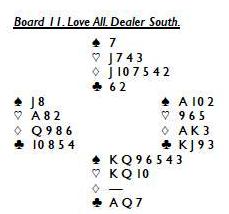The World Wide Bridge Contest is a long-standing tournament in the World Bridge Federation’s calendar, 2013 is its 27th year, and I do hope you all enjoyed this event and found the hands interesting and challenging – my thanks go to Eric Kokish for his excellent and most entertaining commentary. Gianarrigo Rona, President, World Bridge Federation.

The powerful South hand would have a fine play for game opposite the ![]() J and three low trumps, or a few other very weak North hands, and some will drive to 4
J and three low trumps, or a few other very weak North hands, and some will drive to 4 ![]() after opening with a forcing bid. Acol two-bidders, their French cousins who feature two tiers of strong two-bids (gameforcing and “semi-forcing”), some 2
after opening with a forcing bid. Acol two-bidders, their French cousins who feature two tiers of strong two-bids (gameforcing and “semi-forcing”), some 2![]() openers who can stop short of game opposite a double negative, and quite a few of the strong clubbers, are more likely to stop at 3
openers who can stop short of game opposite a double negative, and quite a few of the strong clubbers, are more likely to stop at 3![]() .
.
Those who open 1![]() will face a vastly different set of conditions, as North will usually pass (though some forcing 1NT aficionados might try to improve the contract or give their opponents a harder time), leaving East to protect with double or 1NT, according to partnership style and agreement. Where East doubles, South can redouble with the intention of bidding spades as often as necessary later, or South could jump to 3
will face a vastly different set of conditions, as North will usually pass (though some forcing 1NT aficionados might try to improve the contract or give their opponents a harder time), leaving East to protect with double or 1NT, according to partnership style and agreement. Where East doubles, South can redouble with the intention of bidding spades as often as necessary later, or South could jump to 3![]() to make it more difficult for E/W to find a profitable fit. Both strategies have merit and N/S figure to buy the contract at 2
to make it more difficult for E/W to find a profitable fit. Both strategies have merit and N/S figure to buy the contract at 2![]() or 3
or 3![]() at these tables. Where East reopens with 1NT, South will double or bid 2
at these tables. Where East reopens with 1NT, South will double or bid 2![]() or 3
or 3![]() , all of which might well end the auction, though North might pull a double to 2
, all of which might well end the auction, though North might pull a double to 2 ![]() , which might convince South to bid a bit less.
, which might convince South to bid a bit less.
To hold a spade contract to just eight tricks, West must lead the ![]() J (this would not be a good time to rely on the traditional wisdom that advocates leading the lowest trump lest declarer take East’s ten with the king at trick one and continue with the queen). Later, West must duck the king and queen of hearts or rise with the ace should declarer try to sneak the ten past him; if the defense gets everything right and retains sufficient safe exit cards in diamonds, declarer can be prevented from taking a trick with the
J (this would not be a good time to rely on the traditional wisdom that advocates leading the lowest trump lest declarer take East’s ten with the king at trick one and continue with the queen). Later, West must duck the king and queen of hearts or rise with the ace should declarer try to sneak the ten past him; if the defense gets everything right and retains sufficient safe exit cards in diamonds, declarer can be prevented from taking a trick with the ![]() Q, which would be his ninth winner. E/W pairs who find this defense will have something special to offer in the post-session social activities.
Q, which would be his ninth winner. E/W pairs who find this defense will have something special to offer in the post-session social activities.
Worst-case scenario for E/W is for West to lead a club against a spade contract, allowing declarer to take two club winners and ruff his low club in dummy, cruising home with 10 tricks for +170 or a wonderful +420.
Although the club lead will be quite common, many Wests will prefer to lead from strength, opting for the six, eight or nine of diamonds, according to partnership agreement. If declarer covers West’s diamond spot the position will be clear to the defense, but declarer can eventually reach a position where someone will have to play a club for him. In one variation, East will have an exit card available in diamonds, but declarer will be able to discard the ![]() 7 and allow West to win his
7 and allow West to win his ![]() Q, but West, out of major-suit cards, will have to give dummy the
Q, but West, out of major-suit cards, will have to give dummy the ![]() J or lead into the ace-queen of clubs.
J or lead into the ace-queen of clubs.
E/W +50 will be excellent as there won’t be many +100s for 4 ![]() down two or 4
down two or 4 ![]() doubled down one or +300s for 4
doubled down one or +300s for 4 ![]() doubled down two.
doubled down two.
